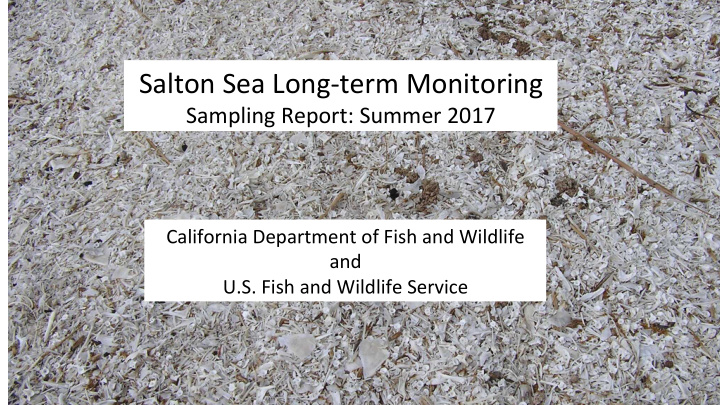



Salton Sea Long-term Monitoring Sampling Report: Summer 2017 California Department of Fish and Wildlife and U.S. Fish and Wildlife Service
Pa Par$cipa$ng Stafff CA Department of Fish and Wildlife: • Sam Haynes • Jose Figueroa • Jack Crayon U.S. Fish and Wildlife Service: • Tom Anderson • Ryan Woody • Sara Miller • MaJ Salkiewicz
Ra$onale • Fisheries were last surveyed in Fall 2008 • These indicators were previously closely associated with fish numbers • Good numbers of piscivorous birds • Young Rlapia were visible • Great angler success • Large fish kills with arrange of fish sizes • Indicators in early 2016 started to diminish
Methods • Limited by useable launch sites (Varner Harbor, Obsidian BuJe) • Used a subset of previous sites: 3 by rivers and 3 nearshore sites • Used the same gear and amount of effort at each site • MulR-mesh monofilament nets 6 feet deep • Five X 30 foot secRons with .5, 1, 2, 3, and 4 “ mesh nets • Moved sampling sites out to deeper water • Summer sampling period was always the most producRve: sampled from July 13 to August 8
- Two Launch Sites - Three sites by Rivers - Three nearshore sites - North/South split
Methods • Limited by useable launch sites (Varner Harbor, Obsidian BuJe) • Used a subset of previous sites: 3 by rivers and 3 nearshore sites • Used the same gear and amount of effort at each site • Two nets per site • MulR-mesh monofilament nets 6 feet deep • Five secRons, 30 foot long with 0.5, 1, 2, 3, and 4 “ mesh nets • Moved sampling sites out to deeper water • Summer sampling period was always the most producRve: sampled from July 13 to August 8
Date Site Net-hours Tilapia Croaker Corvina Sargo Other Total Fish CPUE Whitewater River 7/9/2008 24 565 0 0 0 0 565 23.79 North Shore 7/10/2008 24 735 0 0 0 2 molly 737 30.63 Bat Caves 7/16/2008 24 876 0 0 0 0 876 36.12 Desert Shores 7/8/2008 24 683 0 0 0 0 683 28.76 The Dome 7/22/2008 24 648 0 0 0 0 648 26.72 The Cliffs 7/17/2008 24 1060 0 0 0 0 1060 43.71 New River 8/1/2008 24 371 0 0 0 0 371 15.46 Test Base 8/1/2008 24 781 0 0 0 0 781 32.54 So. Salton City 7/23/2008 24 723 0 0 0 0 723 30.13 Alamo River 7/18/2008 24 570 0 0 0 0 570 23.51 No.Wister 7/18/2008 24 630 0 0 0 0 630 25.98 Totals 265 7642 0 0 0 2 7644 28.87
Results Date Site Net-hours Tilapia Croaker Corvina Sargo Other Total Fish CPUE Alamo River 7/14/2017 48.0 67 0 0 0 0 67 1.40 New River 7/20/2017 48.0 48 0 0 0 0 48 1.00 Test Base* 7/26/2017 48.0 1 0 0 0 0 1 0.02 North Shore 7/27/2017 55.0 39 0 0 0 0 39 0.71 Bat Caves** 8/3/2017 47.5 4 0 0 0 0 4 0.08 Whitewater 8/8/2017 48.0 168 0 0 0 0 168 3.50 The Dome The Cliffs Desert Shores So. Salton City No.Wister Totals 294.5 327 0 0 0 2 327 1.11 * Nets were coated on top 1/3 by colonizing barnacles, and coated with algae. Mesh was visible to fish. ** Nets were heavily coated with algae, and mesh was highly visible Size Class 1 Size Class 2 Size Class 3 Range (mm) n % Range (mm) n % Range (mm) n % Summer ‘17 64-76 28 9 80-200 128 39 279-394 171 52
Results River sites were low, but not terrible Nearshore sites were the lowest ever sampled
- Two Launch Sites - Three sites by Rivers - Three nearshore sites - North/South split (1.4 vs 0.8 CPUE)
What about the birds? • Dispersing young Brown Pelicans showed up as usual in early summer: ~2,000 birds • Eared Grebe numbers at Mono Lake crashed the last two years • A very wet winter allowed many American White Pelicans to stay up north • Double-crested Cormorants show a lot of variance in nesRng site and foraging site fidelity • Piscivorous birds have been documented by mulRple observers feeding on Rlapia, especially at the north end of the lake • We can’t equate declines in the forage base at the Salton Sea directly with a reducRon in populaRon numbers • The status of several important macroinvertebrates is a crucial unknown factor
What Do We Know? • Fish populaRon has taken a huge hit • DistribuRon of remaining fish is patchy • Tilapia reproducRon took place this year • Historic Rlapia breeding sites have been abandoned • There is structure to the populaRon • However, fish numbers are the lowest we have ever seen in the summer • Birds numbers are low, but not all gone • Piscivorous birds sRll have a reduced forage base • Barnacles are sRll hanging on
What Can We Infer? • We CAN’T infer that the fishery is done for; we have seen remarkable recovery from these populaRon levels in the recent past • Salinity is a primary stressor (among several) yet fish appear robust and vital • Hydrogen sulfide upwellings are sRll the primary driver of fish mortality • Surveys next summer will be revealing • The status of the several macroinvertebrate populaRons will become more valuable informaRon
Recommend
More recommend